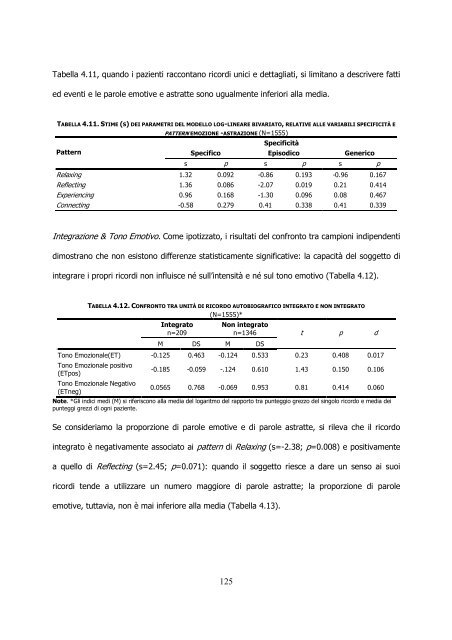LA NARRAZIONE AUTOBIOGRAFICA E IL FUNZIONAMENTO DEL SÉ
LA NARRAZIONE AUTOBIOGRAFICA E IL FUNZIONAMENTO DEL SÉ
LA NARRAZIONE AUTOBIOGRAFICA E IL FUNZIONAMENTO DEL SÉ
You also want an ePaper? Increase the reach of your titles
YUMPU automatically turns print PDFs into web optimized ePapers that Google loves.
Tabella 4.11, quando i pazienti raccontano ricordi unici e dettagliati, si limitano a descrivere fatti<br />
ed eventi e le parole emotive e astratte sono ugualmente inferiori alla media.<br />
TABEL<strong>LA</strong> 4.11. STIME (S) DEI PARAMETRI <strong>DEL</strong> MO<strong>DEL</strong>LO LOG-LINEARE BIVARIATO, RE<strong>LA</strong>TIVE ALLE VARIAB<strong>IL</strong>I SPECIFICITÀ E<br />
PATTERN EMOZIONE -ASTRAZIONE (N=1555)<br />
Pattern<br />
125<br />
Specificità<br />
Specifico Episodico Generico<br />
s p s p s p<br />
Relaxing 1.32 0.092 -0.86 0.193 -0.96 0.167<br />
Reflecting 1.36 0.086 -2.07 0.019 0.21 0.414<br />
Experiencing 0.96 0.168 -1.30 0.096 0.08 0.467<br />
Connecting -0.58 0.279 0.41 0.338 0.41 0.339<br />
Integrazione & Tono Emotivo. Come ipotizzato, i risultati del confronto tra campioni indipendenti<br />
dimostrano che non esistono differenze statisticamente significative: la capacità del soggetto di<br />
integrare i propri ricordi non influisce né sull’intensità e né sul tono emotivo (Tabella 4.12).<br />
TABEL<strong>LA</strong> 4.12. CONFRONTO TRA UNITÀ DI RICORDO AUTOBIOGRAFICO INTEGRATO E NON INTEGRATO<br />
(N=1555)*<br />
Integrato<br />
n=209<br />
Non integrato<br />
n=1346<br />
M DS M DS<br />
Tono Emozionale(ET) -0.125 0.463 -0.124 0.533 0.23 0.408 0.017<br />
Tono Emozionale positivo<br />
(ETpos)<br />
Tono Emozionale Negativo<br />
(ETneg)<br />
-0.185 -0.059 -.124 0.610 1.43 0.150 0.106<br />
0.0565 0.768 -0.069 0.953 0.81 0.414 0.060<br />
Note. *Gli indici medi (M) si riferiscono alla media del logaritmo del rapporto tra punteggio grezzo del singolo ricordo e media dei<br />
punteggi grezzi di ogni paziente.<br />
Se consideriamo la proporzione di parole emotive e di parole astratte, si rileva che il ricordo<br />
integrato è negativamente associato ai pattern di Relaxing (s=-2.38; p=0.008) e positivamente<br />
a quello di Reflecting (s=2.45; p=0.071): quando il soggetto riesce a dare un senso ai suoi<br />
ricordi tende a utilizzare un numero maggiore di parole astratte; la proporzione di parole<br />
emotive, tuttavia, non è mai inferiore alla media (Tabella 4.13).<br />
t<br />
p<br />
d

















